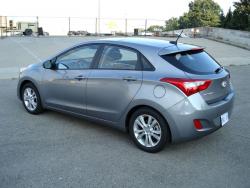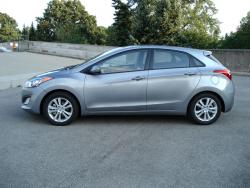 2013 Hyundai Elantra GT GLS manual. Click image to enlarge |
| First Drive: 2013 Hyundai Elantra GT
Manufacturer’s web site |
Review and photos by Mike Schlee
Photo Gallery:
2013 Hyundai Elantra GT
There is a well-documented war being waged right now in the compact car market between the two big H’s. Hyundai and Honda are battling it out for the coveted crown of #1 selling car in Canada. Their weapons of choice are the Honda Civic and Hyundai Elantra. For the past 14 years Honda has claimed the title of ‘bestselling car in Canada’ as the Civic has topped the charts every one of those years. However, in 2011 the Elantra just about bumped the Civic from its throne and if it were not for the amazing interest rates on the Civic late last year, it may have happened.
Now in 2012, the Civic is once again sitting at number one as we pass the halfway point in the year. Hyundai, though, is not one to sit back and settle for second best. Instead, they are initiating an all-out assault on the Civic by introducing two new models for 2013: the Elantra GT and the Elantra Coupe.
   2013 Hyundai Elantra GT GLS manual. Click image to enlarge |
The Elantra Coupe is pretty self explanatory, but what is an Elantra GT? Well, it is the hatchback version of the Elantra, of course! For reasons unbeknownst to this reviewer, some car companies have taken it upon themselves to ensure all hatchback naming conventions of their five-door compact car variants must exude performance and speed. Mazda has the Mazda3 Sport and Mitsubishi takes things one step further with the Lancer Sportback. Even Hyundai used to call the previous generation Elantra hatchback the Touring.
Fancy name aside, don’t expect the Hyundai Elantra GT to be any sportier than its coupe or sedan counterparts. It does receive an upgraded suspension over the Elantra Sedan via a V-beam torsion axle in the rear with integrated 22-mm stabilizer bar, a similar setup to the Veloster. As well, it is the only one of the Elantra trio to receive unique Sachs dampers and suspension calibrations. All of this suspension work adds up to a very planted feel on the road. The Elantra GT feels more secure and sucked down to the road than its 1,324 kg weight would suggest, yet is still light and agile in the corners. That is not to say it cuts up the corners, but it does hang on surprisingly well when pushed through the twisties and is ultimately let down by its non-sporting 205/55R16 tires.
The ride is comfortable on both smooth and rough pavement, but the suspension is prone to clump and thump over bumps, albeit only mildly. The suspension is more sorted out than the one in the Elantra sedan as the unfavourable quivers over uneven broken pavement has been mostly dialed out. Road noise on the whole is subdued, but the engine is loud and unpleasant at higher rpms. A cool trick feature of the Elantra GT is the adjustable electric steering that can be cycled through three modes, comfort, normal, and sport, via a button on the steering wheel. The only real difference between these modes is steering effort; feedback and feel are unaffected. So the Elantra’s steering is still numb and artificial, but at least Hyundai is making an effort to fix it.
The GT comes equipped with a 1.8L four-cylinder engine developing 148 hp and 131 ft-lb of torque, and the choice of a six-speed manual transmission or six-speed automatic. The manual is only available on GL and GLS trim Elantra GTs and not the top of the line SE. Luckily for me, I was in a 2013 Elantra GT GLS with the manual.
     2013 Hyundai Elantra GT GLS manual. Click image to enlarge |
The 6-speed unit is a bit unique as it features a button on the gear shifter located on the bottom front of the shift knob—a location similar to buttons on automatic transmission gear levers. This button controls the reverse lockout that prevents you from putting the car in reverse by accident. However, due to a strange habit I have of tapping automatic gear lever buttons while waiting at red lights, I found myself accidently depressing this lever while moving the lever over to first gear and travelling too far into the reverse gate. I’m happy to report that I never backed into anyone when the light turned green though.
The transmission and clutch pedal both require light effort and engage relatively smoothly. Combined with the 1.8L engine, forward thrust is initially strong but quickly tails off, as is to be expected in the compact car segment. On the highway the engine spins at 2,850 rpm @ 120 km/h and 2,400 rpm @ 100 km/h. Being a compact car, fuel efficiency is a prime concern and despite impressive ratings from Natural Resources Canada of 7.3 L/100 km city and 4.9 L/100 km highway, all I was able to achieve over my week with the car was an 8.7 L/100 km average.
The Elantra sedan has been a bit polarizing on looks; some people love it while others would rather leave it. I have always fallen into the latter camp as I find the sedan’s curvaceous body to be a little over the top. However, I really like the new rear hatch design. The creased body work and restrained taillights give it a nice, modern look. The front is still a bit over the top for me, but even it seems more subdued when attached to the GT’s rear end. I also really appreciate that most pieces on the exterior are body coloured and not left in ‘unfinished’ black or gray plastic.
Inside, the Elantra features a modern design executed in a mix of hard and soft-touch materials. Overall, the entire dash looks contemporary if not restrained. All GLS and SE versions of the Elantra GT come standard with a dual pane panoramic sunroof that dominates the roof of the vehicle. This roof is great and adds a bright, airy feel to the cabin but did seem to squeak and rattle a bit on the road. As well, it cuts into rear headroom and those approaching six feet tall will need to slouch forward in the rear seats to keep their heads off the roof. Thankfully rear legroom is generous for a compact vehicle, as is rear cargo space—651 L with the rear seats up and 1,444 L with the rear seats folded.
The premium cloth seat material is a bit rough to the touch, but the actual seats are comfortable. The GLS’s standard power seat was a welcome convenience that made finding a preferred seating position easy. The GT is also full of storage nooks and crannies everywhere; there are even storage compartments under the rear cargo floor. Not so convenient, though, is the large D pillar created by the swoopy hatchback roofline that makes over-the-shoulder blind spot checks difficult; better ensure your mirrors are set up properly.
Will the Elantra GT, in partnership with the new Elantra Coupe, finally knock off the almighty Civic? Only time will tell, but there is quite a sales deficit to make up for in 2012 already. What I can tell you though is that the Elantra GT is at the forefront of the compact car segment in Canada, as can be seen from its recent win in our three-car Compact Comparison Test. The Hyundai juggernaut just keeps on rolling along.
Pricing: 2013 Hyundai Elantra GT GLS Manual
Base price: $21,349
Options: None
A/C tax: $100
Freight: $1,495
Price as tested: $22,944
Specifications
TBD
Competitors











